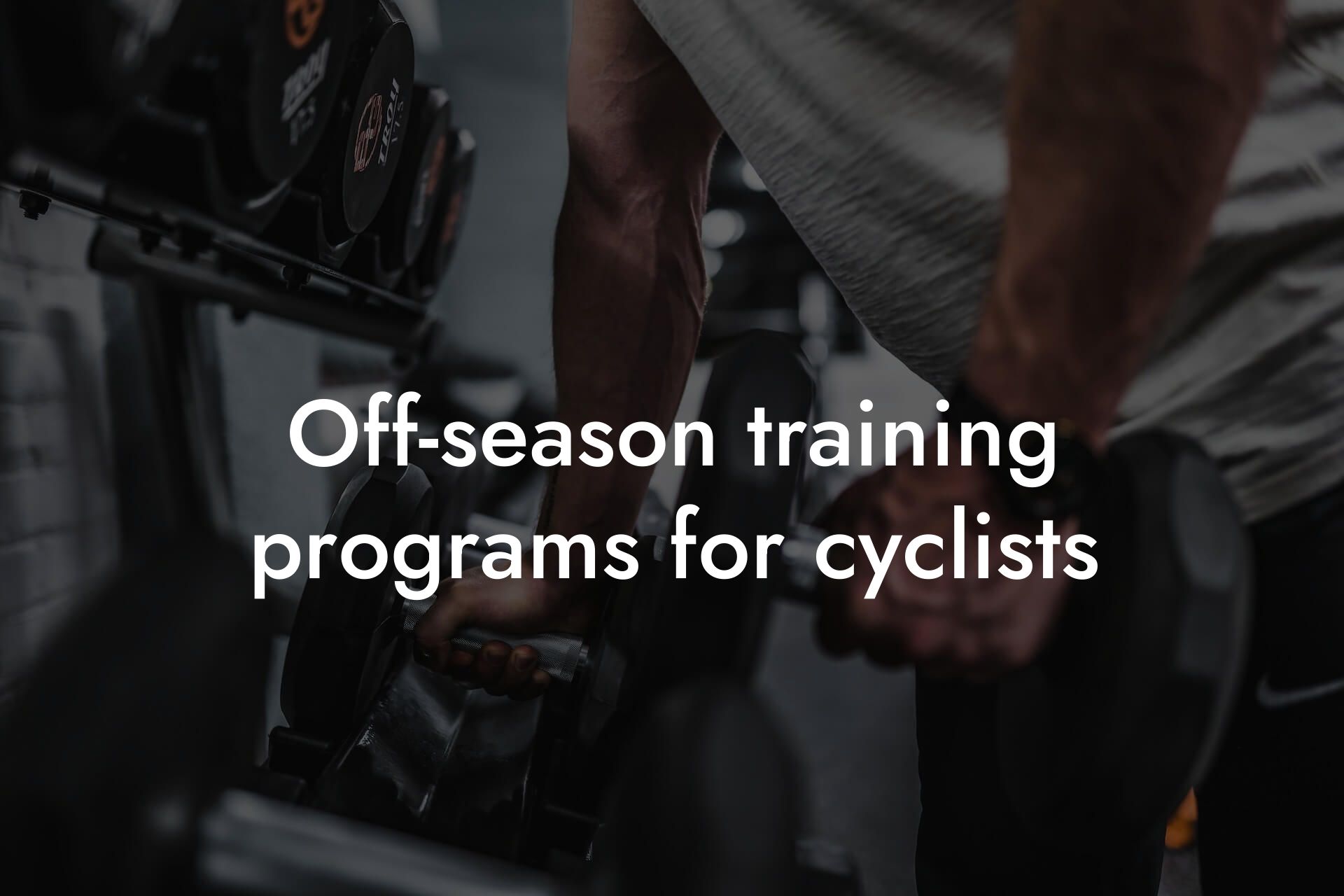As a high-earning professional, you understand the importance of optimizing your physical performance to maintain a competitive edge in your career and personal life. As a cyclist, you're likely aware of the importance of building power output to improve your overall cycling performance. One of the most effective ways to achieve this is through strength training. In this article, we'll delve into the world of strength training for cyclists, exploring the benefits, exercises, and tips to help you take your cycling to the next level.
Table of Contents
- Why Strength Training is Essential for Cyclists
- Key Muscle Groups for Cyclists
- Essential Strength Training Exercises for Cyclists
- Periodized Strength Training for Cyclists
- Incorporating Strength Training into Your Cycling Routine
- Common Mistakes to Avoid
- Tracking Progress and Setting Goals
- Frequently Asked Questions
Why Strength Training is Essential for Cyclists
As a cyclist, you may think that cardio is the only way to improve your performance. However, neglecting strength training can lead to plateaus, injuries, and decreased overall performance. Strength training is essential for cyclists because it helps to:
• Increase power output: By building strength in your legs, core, and upper body, you'll be able to generate more power and speed on the bike.
• Improve efficiency: Strength training helps to increase your pedaling efficiency, allowing you to maintain a higher cadence and conserve energy.
• Enhance endurance: By building strength in your muscles, you'll be able to sustain longer periods of high-intensity cycling.
• Reduce injury risk: Strengthening your muscles and connective tissues helps to reduce the risk of injuries, particularly in the knees, hips, and lower back.
Key Muscle Groups for Cyclists
When it comes to strength training for cycling, there are several key muscle groups to focus on:
• Legs: Quadriceps, hamstrings, glutes, and calves are essential for generating power and speed on the bike.
• Core: A strong core helps to maintain good posture, stability, and efficiency on the bike.
• Upper body: Strengthening your arms, shoulders, and back helps to improve your overall cycling posture and reduce fatigue.
Essential Strength Training Exercises for Cyclists
Here are some essential strength training exercises to include in your workout routine:
• Squats: Works the quadriceps, hamstrings, and glutes.
• Lunges: Targets the quadriceps, hamstrings, and glutes.
• Deadlifts: Works the glutes, hamstrings, and lower back.
• Leg Press: Targets the quadriceps, hamstrings, and glutes.
• Calf Raises: Strengthens the calf muscles.
• Planks: Engages the core and improves overall stability.
• Dumbbell Rows: Targets the upper back and arms.
• Shoulder Press: Strengthens the shoulders and upper back.
Periodized Strength Training for Cyclists
Periodized strength training involves varying your workout routine to avoid plateaus and ensure continued progress. Here's a general outline to follow:
• Base phase (4-6 weeks): Focus on building overall strength and endurance with higher volume and lower intensity workouts.
• Build phase (4-6 weeks): Increase intensity and decrease volume to build power and speed.
• Peak phase (2-4 weeks): Focus on high-intensity, low-volume workouts to maximize power output.
• Recovery phase (2-4 weeks): Reduce intensity and volume to allow for recovery and rebuilding.
Incorporating Strength Training into Your Cycling Routine
As a busy professional, it can be challenging to fit strength training into your already packed schedule. Here are some tips to help you incorporate strength training into your cycling routine:
• Start with 1-2 strength training sessions per week and gradually increase frequency as you build strength and endurance.
• Aim to strength train on non-consecutive days to allow for recovery.
• Incorporate strength training exercises into your warm-up or cool-down routine.
• Use bodyweight exercises or resistance bands when you're short on time or don't have access to a gym.
Common Mistakes to Avoid
Here are some common mistakes to avoid when it comes to strength training for cycling:
• Neglecting to warm up or cool down properly.
• Focusing too much on cardio and neglecting strength training.
• Not incorporating exercises that target the core and upper body.
• Not allowing for adequate recovery time between strength training sessions.
Tracking Progress and Setting Goals
As with any training program, it's essential to track your progress and set goals to stay motivated and focused. Here are some tips to help you track your progress and set goals:
• Use a training log or app to track your workouts and progress.
• Set specific, measurable, and achievable goals, such as increasing your power output or completing a certain number of strength training sessions per week.
• Use a DEXA machine to track changes in your body composition and bone density.
• Work with a coach or trainer to help you develop a personalized training plan and provide accountability.
Strength training is a crucial component of any cyclist's training program. By incorporating strength training exercises into your routine, you'll be able to improve your power output, efficiency, and overall cycling performance. Remember to focus on key muscle groups, periodize your training, and track your progress to stay motivated and focused. With the right approach, you'll be able to take your cycling to the next level and achieve your goals.
At Tano Performance Group, we're dedicated to helping high-earning professionals like you achieve their fitness goals. Our state-of-the-art DEXA machine provides a comprehensive body assessment, giving you the information you need to optimize your training and nutrition. Contact us today to learn more about how we can help you take your performance to the next level.
Frequently Asked Questions
What is strength training, and how does it benefit cyclists?
Strength training is a type of exercise that focuses on building muscle mass and increasing muscular strength. For cyclists, strength training can improve power output, endurance, and overall performance on the bike. By incorporating strength exercises into their training routine, cyclists can increase their pedaling efficiency, reduce fatigue, and enhance their overall cycling experience.
Why is power output important for cyclists?
Power output is a critical component of cycling performance, as it directly affects a cyclist's speed, acceleration, and overall efficiency on the bike. By increasing power output, cyclists can ride faster, longer, and with greater ease, giving them a competitive edge in races and events.
How does strength training improve power output in cyclists?
Strength training improves power output in cyclists by increasing the force and speed at which they can pedal. This is achieved through exercises that target the muscles used in cycling, such as the legs, core, and glutes. By building strength in these areas, cyclists can generate more power with each pedal stroke, leading to improved performance and efficiency.
What types of strength exercises are best for cyclists?
Cyclists should focus on exercises that target the muscles used in cycling, such as squats, lunges, deadlifts, and leg press. These exercises help build strength in the legs, glutes, and core, which are essential for generating power on the bike. Additionally, exercises that target the upper body, such as push-ups and rows, can help improve overall cycling efficiency and reduce fatigue.
How often should cyclists incorporate strength training into their routine?
Cyclists should aim to incorporate strength training into their routine 2-3 times per week, with at least one day of rest in between. This allows for adequate recovery time and ensures that the muscles are not overworked or fatigued.
Can strength training be done at home, or do I need to join a gym?
Strength training can be done at home with minimal equipment, such as resistance bands or dumbbells. However, joining a gym can provide access to a wider range of equipment and expertise from personal trainers. Ultimately, the choice between home-based training and gym-based training depends on personal preference and availability.
How long does it take to see improvements in power output from strength training?
The amount of time it takes to see improvements in power output from strength training varies depending on individual factors, such as current fitness level and training frequency. However, with consistent training and progressive overload, cyclists can expect to see noticeable improvements in power output within 6-12 weeks.
Will strength training make me bulk up and lose my cycling endurance?
No, strength training will not make you bulk up and lose your cycling endurance. When done correctly, strength training can actually improve cycling endurance by increasing muscular efficiency and reducing fatigue. Additionally, strength training can help cyclists maintain their lean muscle mass, which is essential for optimal cycling performance.
Can strength training help with injury prevention?
Yes, strength training can help with injury prevention by building strength and resilience in the muscles and connective tissues. This can reduce the risk of overuse injuries, such as tendonitis and muscle strains, which are common in cycling.
How does strength training affect bone density in cyclists?
Strength training can help improve bone density in cyclists, particularly in the hips, spine, and legs. This is because strength exercises stimulate bone growth and density, which can reduce the risk of osteoporosis and fractures.
Can strength training be adapted for different fitness levels and goals?
Yes, strength training can be adapted for different fitness levels and goals. For example, beginners can start with lighter weights and progress gradually, while more advanced cyclists can focus on more intense and specific exercises. Additionally, strength training can be tailored to specific goals, such as improving power output or increasing endurance.
How does strength training impact body composition in cyclists?
Strength training can help cyclists maintain a lean and athletic body composition by building muscle mass and reducing body fat. This can improve overall cycling performance and enhance physical appearance.
Can strength training be done year-round, or should it be periodized?
Strength training can be done year-round, but it's recommended to periodize training to avoid plateaus and prevent overtraining. This involves alternating between periods of intense strength training and periods of lighter training or active recovery.
How does strength training affect cycling technique and efficiency?
Strength training can improve cycling technique and efficiency by building strength and control in the muscles used in cycling. This can help cyclists maintain a more efficient pedaling technique, reduce energy waste, and improve overall cycling performance.
Can strength training be combined with other forms of training, such as cardio and flexibility exercises?
Yes, strength training can be combined with other forms of training, such as cardio and flexibility exercises, to create a well-rounded and comprehensive training program. This can help cyclists improve overall fitness and performance.
How does strength training impact mental toughness and confidence in cyclists?
Strength training can help improve mental toughness and confidence in cyclists by building physical strength and resilience. This can translate to improved mental toughness and confidence on the bike, allowing cyclists to push themselves harder and perform at a higher level.
Can strength training be done with a coach or personal trainer, or is self-directed training sufficient?
Both options are viable, depending on individual preferences and needs. Working with a coach or personal trainer can provide expert guidance and accountability, while self-directed training allows for greater flexibility and autonomy.
How does strength training fit into a cyclist's overall training program?
Strength training should be incorporated into a cyclist's overall training program as a complementary component, alongside cardio and endurance training. This can help create a well-rounded and balanced training program that addresses all aspects of cycling performance.
What are some common mistakes to avoid when incorporating strength training into a cycling program?
Common mistakes to avoid include overtraining, inadequate recovery time, and poor exercise form. It's essential to prioritize proper form and technique, listen to your body, and adjust training accordingly to avoid injury or burnout.
How does strength training impact cycling performance in different types of events, such as road racing, mountain biking, and time trialing?
Strength training can benefit cyclists in various types of events, including road racing, mountain biking, and time trialing. By building strength and power, cyclists can improve their performance in these events by increasing their speed, acceleration, and endurance.
Can strength training be adapted for cyclists with physical limitations or injuries?
Yes, strength training can be adapted for cyclists with physical limitations or injuries. By modifying exercises and training protocols, cyclists can work around injuries or limitations and still achieve benefits from strength training.
What are some key takeaways for cyclists looking to incorporate strength training into their program?
Key takeaways include the importance of incorporating strength training into a comprehensive training program, focusing on exercises that target the muscles used in cycling, and prioritizing proper form and technique. Additionally, cyclists should aim to make strength training a consistent part of their routine, with regular sessions and progressive overload.
Here are some related articles you might love...
- Off-season training programs for cyclists
- Bone density and injury prevention for cyclists
- Using DEXA scans to monitor cyclist health and performance
- Recovery strategies for cyclists after intense races
- Nutrition tips for endurance during long cycling races
- The importance of body composition in cycling performance
- Reducing body fat for better power-to-weight ratio in cycling
- The role of muscle mass in cycling endurance
- Hydration and nutrition for optimal cycling performance
Zak Faulkner
Zak Faulkner is a leading authority in the realm of physical health and body composition analysis, with over 15 years of experience helping professionals optimise their fitness and well-being. As one the experts behind Tano Performance Group, Zak has dedicated his career to providing in-depth, science-backed insights that empower clients to elevate their physical performance and overall health.
With extensive knowledge of DEXA technology, Zak specializes in delivering comprehensive body assessments that offer precise data on body fat, muscle mass, bone density, and overall physique. His expertise enables individuals to make informed decisions and achieve their fitness goals with accuracy and confidence. Zak’s approach is rooted in a deep understanding of human physiology, combined with a passion for helping clients unlock their full potential through personalised strategies.
Over the years, Zak has earned a reputation for his commitment to excellence, precision, and client-focused service. His guidance is trusted by top professionals who demand the best when it comes to their health. Whether advising on fitness programs, nutritional strategies, or long-term wellness plans, Zak Faulkner’s insights are a valuable resource for anyone serious about taking their health and fitness to the next level.
At Tano Performance Group, Zak continues to lead our Content Team revolutionising how professionals approach their physical health, offering unparalleled expertise that drives real results.




